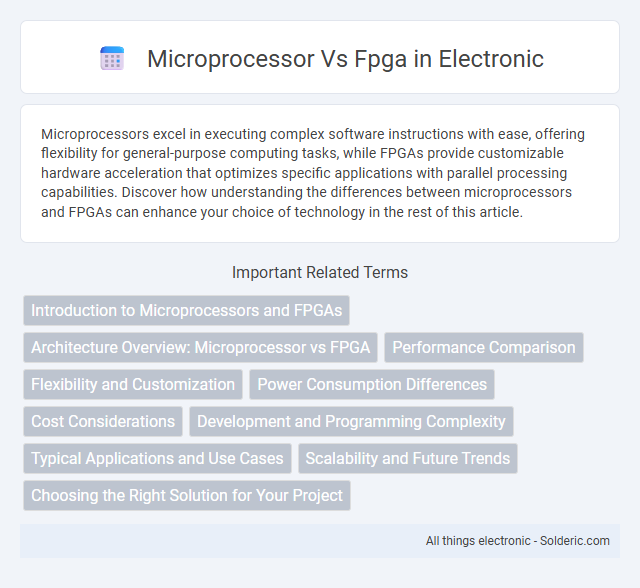Microprocessors excel in executing complex software instructions with ease, offering flexibility for general-purpose computing tasks, while FPGAs provide customizable hardware acceleration that optimizes specific applications with parallel processing capabilities. Discover how understanding the differences between microprocessors and FPGAs can enhance your choice of technology in the rest of this article.
Comparison Table
| Feature | Microprocessor | FPGA (Field-Programmable Gate Array) |
|---|---|---|
| Architecture | Fixed, based on CPU cores | Reconfigurable hardware logic blocks |
| Performance | General-purpose, limited parallelism | High parallelism, customizable datapaths |
| Flexibility | Software programmable | Hardware programmable post-manufacturing |
| Development Time | Short, using software tools | Longer, requires hardware design |
| Power Efficiency | Moderate, depends on CPU design | High, optimized for specific tasks |
| Cost | Lower unit cost at scale | Higher unit cost, cost-effective for prototyping |
| Applications | General computing, embedded systems | Signal processing, custom accelerators |
Introduction to Microprocessors and FPGAs
Microprocessors are central processing units designed to execute a fixed instruction set for general-purpose computing tasks, leveraging sequential instruction execution and integrated control logic. FPGAs (Field-Programmable Gate Arrays) consist of a matrix of configurable logic blocks and interconnects that allow hardware-level customization for parallel processing and specialized applications. Understanding the fundamental architectures of microprocessors and FPGAs enables you to choose the most suitable technology for performance, flexibility, and application-specific requirements.
Architecture Overview: Microprocessor vs FPGA
Microprocessors feature a fixed, sequential architecture with a central processing unit designed to execute instructions stored in memory, optimizing general-purpose computing tasks. FPGAs offer a reconfigurable architecture composed of an array of programmable logic blocks interconnected via customizable routing, enabling parallel processing tailored to specific applications. Understanding the architectural differences helps you choose between the flexibility and speed of FPGAs or the ease and compatibility of microprocessors for your computational needs.
Performance Comparison
Microprocessors excel in executing sequential instructions efficiently, making them ideal for general-purpose computing tasks with moderate complexity. FPGAs offer superior parallel processing capabilities by allowing custom hardware configurations, which significantly enhances performance in specialized, compute-intensive applications such as signal processing and real-time data analysis. Benchmark studies show FPGAs achieve lower latency and higher throughput compared to microprocessors when handling highly parallelizable tasks.
Flexibility and Customization
FPGAs offer exceptional flexibility and customization by allowing hardware-level reconfiguration tailored to specific applications, enabling parallel processing and optimized performance. Microprocessors provide programmability through software, supporting a wide range of general-purpose tasks but lack the hardware adaptability found in FPGAs. Your choice depends on whether you prioritize customizable hardware acceleration or versatile software execution.
Power Consumption Differences
Microprocessors typically consume more power due to their fixed architecture and continuous clock operation, making them less energy-efficient for specialized tasks. FPGAs offer lower power consumption by allowing customized hardware configurations that activate only necessary circuit blocks. Your choice between them should consider power constraints, especially for battery-operated or energy-sensitive applications.
Cost Considerations
Microprocessors generally offer lower upfront costs due to mass production and standardized designs, making them cost-effective for high-volume applications. FPGAs involve higher initial expenses because of complex hardware and programming requirements but can reduce long-term costs through reconfigurability and adaptability to evolving system needs. Evaluating total cost of ownership includes factors such as development time, unit price, and potential for design updates in deployment.
Development and Programming Complexity
Microprocessors offer simpler development and programming through widely used high-level languages like C and extensive software development kits, making them accessible for general-purpose applications. FPGAs require hardware description languages such as VHDL or Verilog, which demand specialized knowledge and longer design cycles to implement custom parallel processing architectures. Your choice impacts project timelines and team expertise requirements, with microprocessors favoring rapid software development and FPGAs excelling in tailored hardware solutions.
Typical Applications and Use Cases
Microprocessors excel in general-purpose computing tasks such as running operating systems, executing software applications, and handling sequential processing in devices like smartphones and personal computers. FPGAs (Field-Programmable Gate Arrays) are ideal for custom hardware acceleration, real-time signal processing, and applications requiring parallel processing such as telecommunications, aerospace, and high-frequency trading systems. Industries leverage microprocessors for flexibility and ease of programming, while FPGAs are chosen for performance-critical tasks demanding low latency and high throughput.
Scalability and Future Trends
Microprocessors offer scalability through higher clock speeds and multicore architectures, suitable for general-purpose applications requiring evolving software capabilities. FPGAs provide unmatched scalability in hardware parallelism and customizability, enabling rapid adaptation to future AI and edge computing trends. Your choice depends on whether flexible software updates or hardware-level optimization drives your project's scalability needs.
Choosing the Right Solution for Your Project
Selecting between a microprocessor and an FPGA depends on project requirements such as processing speed, flexibility, and development time. Microprocessors offer ease of programming and are ideal for general-purpose computing tasks, while FPGAs provide parallel processing capabilities and hardware-level customization for high-performance applications. Consider factors like power consumption, cost constraints, and the need for real-time processing to determine the optimal solution.
microprocessor vs fpga Infographic

 solderic.com
solderic.com